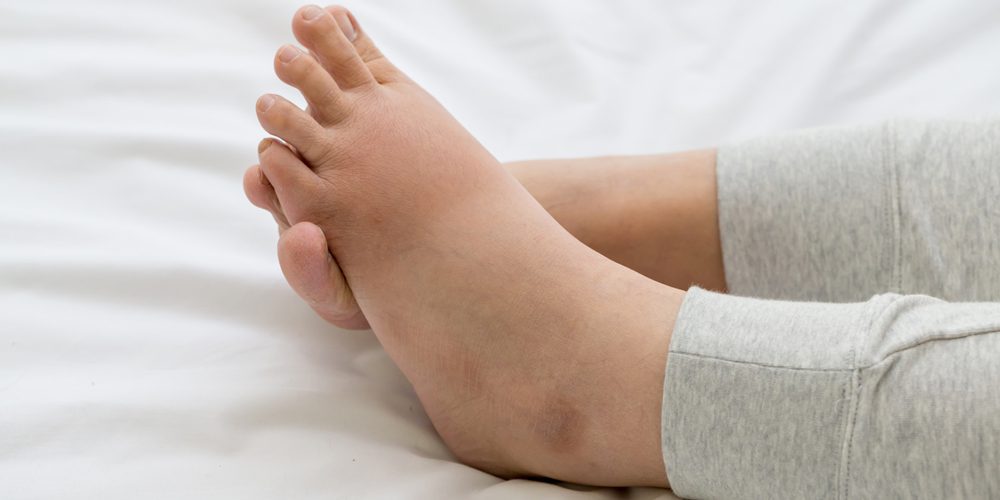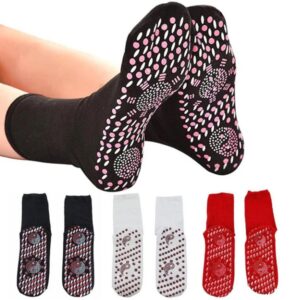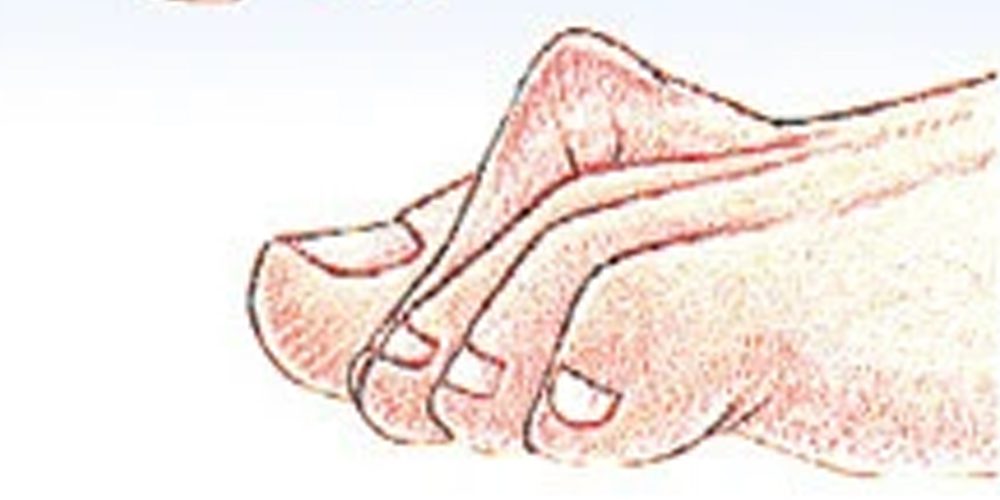If you have ever woken up to find that the top of your foot is swollen, you know how uncomfortable it can be. Several things can cause this condition, and thankfully, there are just as many ways to treat it. Read on to learn more about the top of foot swelling and what you can do about it.
This article is a part of our foot pain series that should work as a complete resource for everything about foot conditions. If you’re interested in reading more about foot pain, you can find the article here.
What to do if the top of the foot is swollen
The first step in dealing with a swollen top of the foot is to figure out the cause. If you can identify the source of the problem, you will be able to better treat the swelling. However, if you cannot pinpoint the cause, there are still some things that you can do to ease the discomfort.
If your top of foot swelling is the result of an injury, you should ice the area for 20 minutes at a time. You can also take over-the-counter pain medication to help with any discomfort. If the swelling does not improve after a few days, or if it gets worse, you should see a doctor.
It is also important to rest your foot as much as possible when the top of it is swollen. This means staying off of it as much as you can and keeping it elevated above your heart. You may also want to wear loose-fitting shoes to avoid putting pressure on the swollen area.
If your top of foot swelling is due to edema, there are a few things that you can do to help reduce the swelling. First, try wearing compression socks or stockings. These garments help to reduce the amount of fluid that builds up in your foot. You should also avoid standing for long periods and, instead, take breaks to elevate your foot.
If the top of your foot is swollen because of an infection, you will need to see a doctor right away. The doctor will prescribe antibiotics to clear up the infection. In the meantime, you can take over-the-counter pain medication and use ice to help with any discomfort.
There are a few different things that can cause the top of the foot to swell. However, with some rest and home treatment, the swelling should go down within a few days. If the swelling does not improve or gets worse, you should see a doctor.
Causes of top of foot swelling
Many different things can cause the top of the foot to swell. Some of the more common causes include:
–Injury: If you injure your foot, it can cause the top of it to swell. This is especially true if you break a bone in your foot or ankle.
–Edema: Edema is a condition that causes fluid to build up in your body. This can lead to swelling in your feet and ankles.
–Infection: An infection in your foot can cause the top of it to swell. This is usually the result of an ingrown toenail or athlete’s foot.
–Vein problems: If you have vein problems, such as varicose veins, they can cause the top of your foot to swell.
–Overuse: If you overuse your foot, it can lead to swelling. This is often the case with athletes or people who stand for long periods of time.
–Poor footwear: Wearing shoes that are too tight or have high heels can cause the top of your foot to swell.
When to see a doctor about the top of foot swelling
If the top of your foot is swollen and you cannot identify the cause, you should see a doctor. This is especially true if the swelling does not go down after a few days or if it gets worse.
A doctor can help to determine the cause of the top of foot swelling and prescribe the appropriate treatment. In some cases, further testing, such as an MRI or X-ray, may be necessary.
DIagnosis when the top of the foot is swollen
If you are experiencing top of foot swelling, there are a few things that your doctor will do to diagnose the problem. First, they will take a medical history and ask about any injuries or illnesses that you have had. They will also ask about your symptoms and when they started.
Next, your doctor will do a physical examination of your foot. They will look for any signs of injury, infection, or vein problems. They may also order X-rays or other imaging tests to rule out other causes of the swelling.
How to treat top of foot swelling
Once your doctor has diagnosed the cause of your top of foot swelling, they will develop a treatment plan. If the swelling is due to an injury, you may need to ice the area and take pain medication. You may also need to wear a splint or cast to immobilize the foot.
If the top of your foot is swollen because of edema, your doctor may recommend wearing compression socks or stockings. They may also suggest that you elevate your foot when possible and avoid standing for long periods of time.
If an infection is causing the top of your foot to swell, your doctor will prescribe antibiotics to clear up the infection. In the meantime, you can take over-the-counter pain medication and use ice to help with any discomfort.
If vein problems are causing the top of your foot to swell, your doctor may recommend wearing compression socks or stockings. They may also suggest that you elevate your foot when possible and avoid standing for long periods. In some cases, surgery may be necessary to correct the problem.
Prevention of top of foot swelling
There are a few things that you can do to prevent top of foot swelling. First, make sure to wear comfortable, supportive shoes. Avoid wearing shoes that are too tight or have high heels. If you are going to be standing for long hours, take breaks and elevate your feet. You should also avoid crossing your legs when sitting down. Finally, if you have edema, make sure to wear compression socks or stockings as directed by your doctor.
The wrong footwear is by far the number one reason for top of foot swelling. And at the same time, this is the easiest thing you can fix on your own. Try more shoe models at a local shop or mall and find a brand, model or type of shoe that fits like a glove without causing any pressure or discomfort.
Heel cushions, insoles and orthotics, gel inserts or other support devices can also be placed inside the shoes to offload any pressure from the top of the foot.
In case you have diabetes or any other medical condition that puts you at risk for top-of-foot wounds, inspect your feet every day and see a doctor at the first sign of redness, swelling or pain in the top of the foot area.
If you are overweight, shedding some pounds may also take the pressure off your feet and help with top of foot swelling.
In most cases, top-of-foot swelling is not a serious condition and can be easily treated at home. However, if the swelling does not go down after a few days or gets worse, you should see a doctor. A doctor can determine the cause of the top of foot swelling and prescribe the appropriate treatment.
Wearing shoes that prevent top of foot swelling
There are a few things to look for when choosing shoes to prevent top of foot swelling. First, make sure that the shoes fit well. They should not be too tight or too loose. Second, the shoes should have a low heel and good arch support. Third, the shoes should be made of breathable materials. Finally, avoid wearing shoes with high heels or pointed toes.
A good starting point are sports shoes / running shoes that offer some arch support. You can also try shoes with a wide toe box to give your toes room to move. Try different brands and models and make sure to walk around in the store. If you visit a store specializing on running shoes, you might be able to get a walk/run analysis and can try some pairs out on a treadmill or device that scientifically measures your feet to find the right shoe for your feet.
Custom-made shoes are an option for people with top-of-foot swelling caused by conditions like diabetes, arthritis or Charcot’s foot. These shoes are designed to fit the specific needs of your feet and can help prevent top-of-foot swelling.
Key Takeaways
– Top of foot swelling is often caused by poor footwear choices, edema, infection, or vein problems.
– If you have top of foot swelling, make sure to see a doctor so they can determine the cause and prescribe the appropriate treatment.
– You can prevent top of foot swelling by wearing comfortable, supportive shoes and taking breaks if you are going to be standing for long periods of time.
– If you have diabetes or any other medical condition that puts you at risk for top-of-foot wounds, inspect your feet every day and see a doctor at the first sign of redness, swelling or pain in the top of the foot area.
– In most cases, top-of-foot swelling is not a serious condition and can be easily treated at home. However, if the swelling does not go down after a few days or gets worse, you should see a doctor.
– Custom-made shoes are an option for people with top-of-foot swelling caused by conditions like diabetes, arthritis or Charcot’s foot. These shoes are designed to fit the specific needs of your feet and can help prevent top-of-foot swelling.
Thank you for taking the time to read this article on top of foot swelling. We hope that you have found it informative and helpful. If you have any experiences or opinions to share, please leave a review below and join the discussion. Thanks again for reading!
























One Response
The top of my right foot is swollen. My
dr. took an x-ray that determined I had a heel spur. My heel does not even hurt. What should I do in this case?